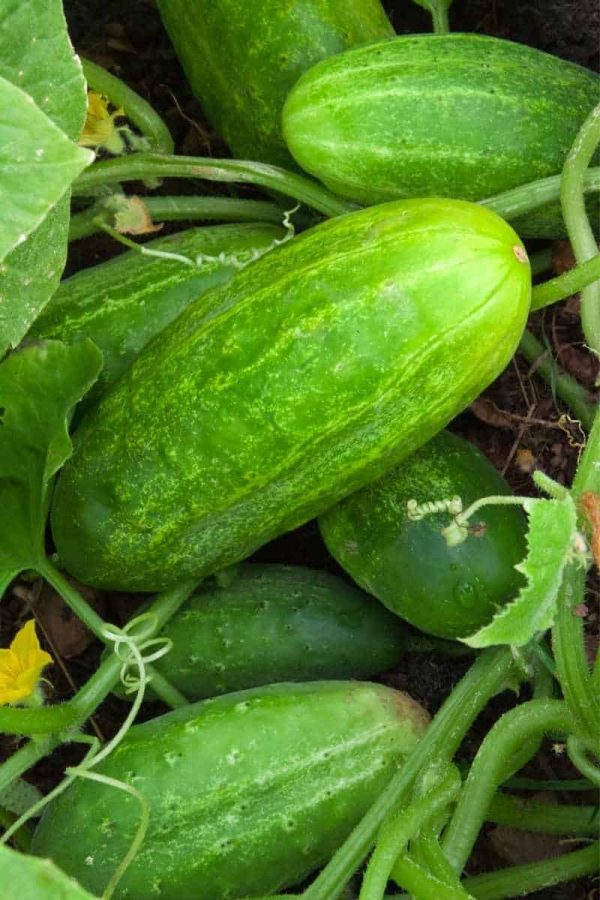When you first start gardening, cucumbers are a natural choice—they are simple to grow, produce a ton of veggies, and are versatile in the kitchen! Cucumbers are great for salads, sandwiches, pickles, and much more.
If you’re looking looking for the ultimate starter’s guide to growing cucumbers, read on! We’ve got you covered.
Table of Contents
Are cucumbers easy to grow?
Yes! Cucumbers make a great addition to any home garden. It’s easy to learn how to grow cucumbers, and they are a good vegetable for beginner gardeners, as long as you have the space.
Do cucumbers need full sun?
Cucumbers are sun-loving plants, and they need at least five hours of direct sunlight a day—although six to eight hours is ideal. Trellising your plants is a great way to provide them with extra sunlight.
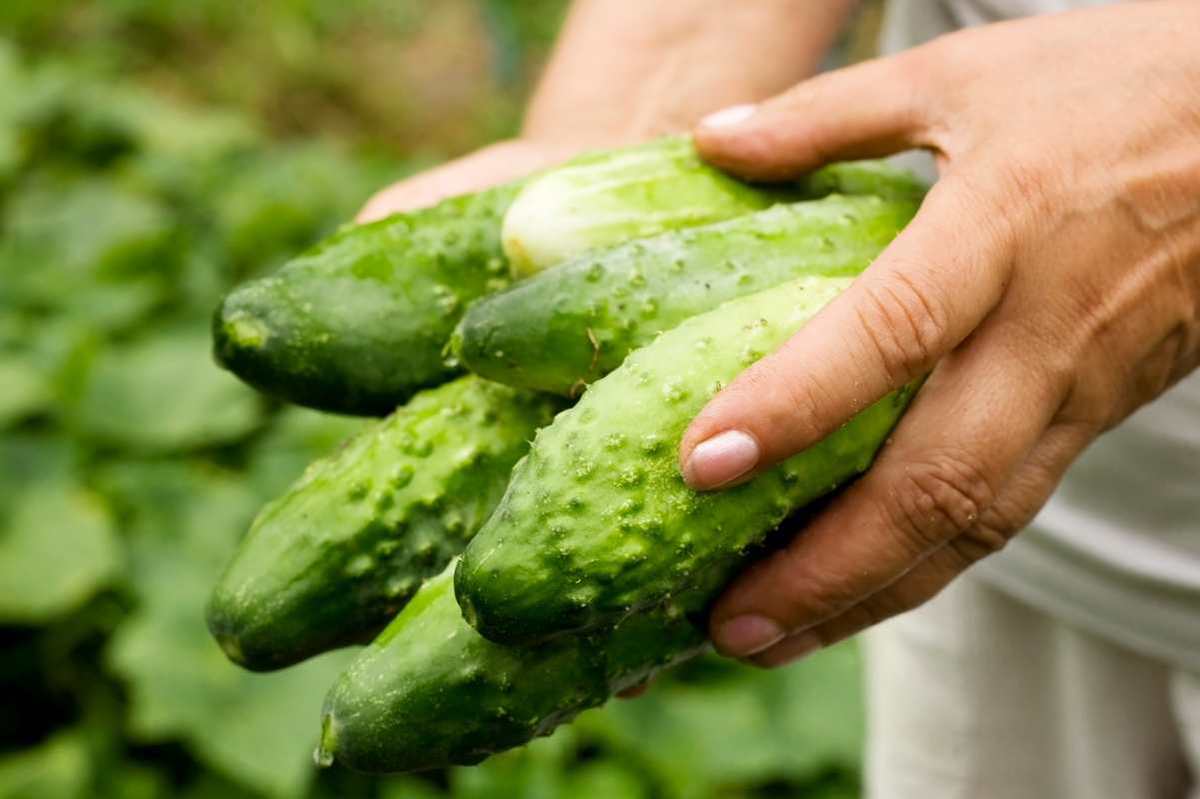
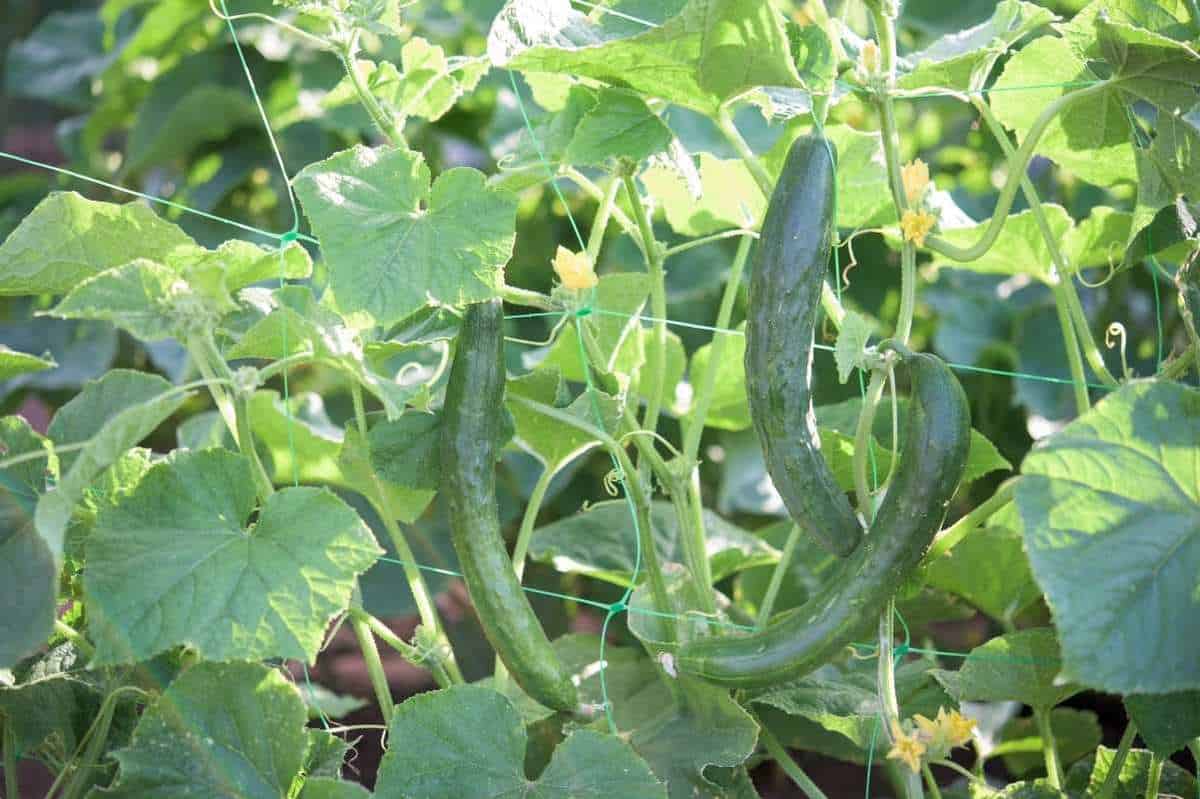
What are the best conditions for growing cucumbers?
Cucumbers need to be planted in a site with full sun. They require well-drained and fertile soil with a soil pH of 6.0-7.0 to grow correctly. Water is vital throughout the growing season—too little water will cause your cucumbers to turn bitter.
Cucumbers grow best when temperatures are above 70°F. Like all cucurbit plants, cucumbers loathe cold snaps, so if the forecast calls for a dip in nighttime temps below 50°F, you can keep your plants happy by using a floating row cover. Just make sure to remove the row cover when flowering begins to allow for pollination.
Where should I plant cucumbers?
Plant your cucumbers in a site with full sun. Cucumbers are large plants that require a lot of nutrients to grow properly. Before planting, enrich the soil with aged manure or compost.
Trellised cucumbers require less garden space, and you can get away with only 18 inches of space per plant. If you choose not to use a trellis for the cucumber plants (more on that in a bit), they need to be planted in a site where they’ll have plenty of room for their vines to spread out.
Growfully Protip
Short on space? Look for some of the bush variety cucumbers that are designed to grow in small spaces or containers. Patio Snacker is one of our favorite bush varieties for container growing.
Types of Cucumbers
There are many varieties of cucumbers to can choose from. Which one you plant will depend on the length of your growing season, how you plan on using the cucumbers, and how much room you have. Here are some of the broader cucumber categories and terms to be familiar with:
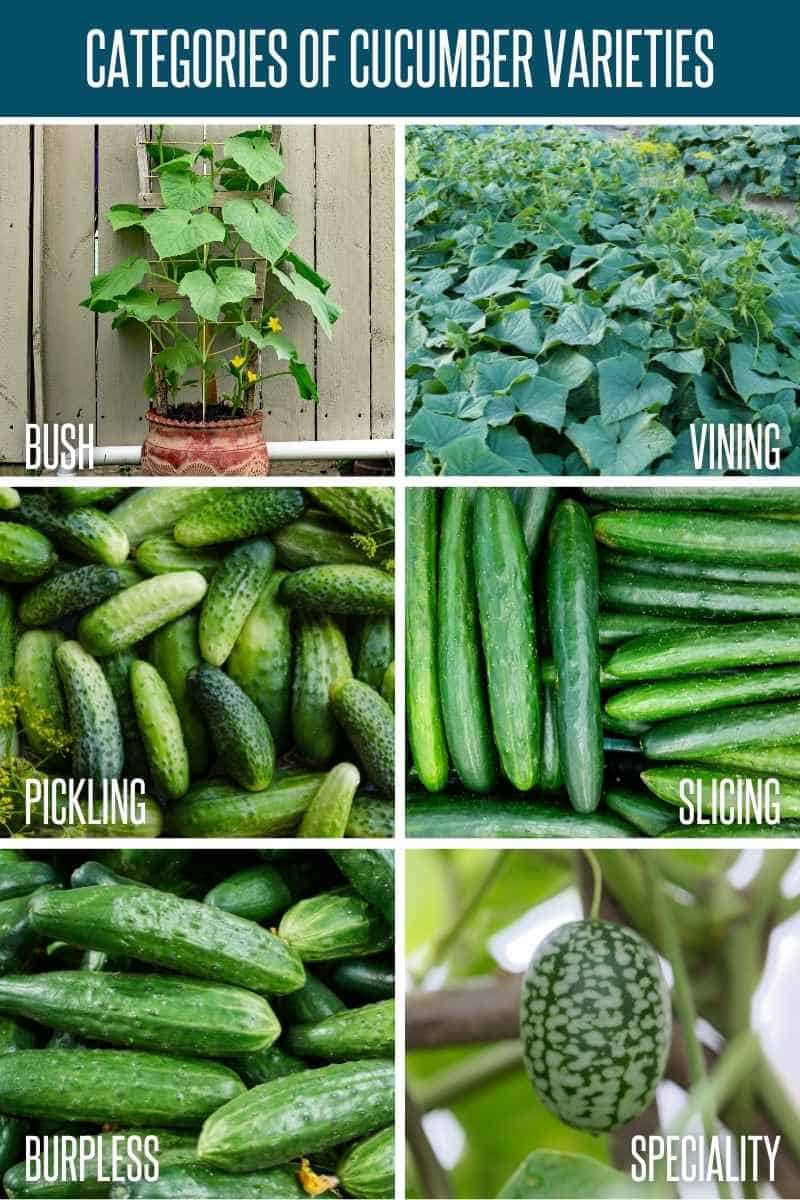
- Bush cucumbers: These cucumbers are compact and need less trellising and support. Most varieties require only two or three feet of space to grow. These are the best variety for growing in containers or small gardens.
- Vining cucumbers: As the name suggests, vining cucumbers produce long vines and require plenty of room. A trellis allows them to grow vertically instead of sending sprawling vines throughout your garden.
- Pickling cucumbers: These cucumbers are shorter, thinner, and more uniform than other varieties of cucumbers. They have thick skin that makes them perfect for pickling. They’re best picked when they’re small.
- Slicing cucumbers: Bred to be eaten fresh, slicing cucumbers are long, narrow, and often smooth. They lack the stiff spines and bumps of pickling cucumbers. They also contain fewer, smaller seeds. These are sometimes called English cucumbers
- Burpless/Seedless cucumbers: A particular type of slicing cucumber, burpless cucumbers have thinner skin and fewer seeds. They’re the sweetest of all the cucumber varieties, and they’re also easier to digest—hence the “burpless” in their name.
- Specialty cucumbers: Flip through any seed catalog and you’ll see tons of fun varieties of cucumbers that we encourage you to try! Some favorites are lemon cucumbers, Mexican Sour Gherkins (AKA: cucamelons), and the giant Armenian cucumber.

What are the best cucumbers to plant?
Choosing the perfect cucumber variety will depend on a lot of factors, but here are the ones we’ve had a lot of success with in the Growfully gardens:
- Patio Snacker (bush): This compact plant is great for those who are growing in containers. It does require a small trellis, but can still be easily grown on a patio or deck. The 4″ mini cukes have great flavor and are perfect for cutting up for a salad.
- Calypso (pickling): During our hot and humid summers, cucumbers often succumb to fungal, bacterial, or viral disease, so we prefer choosing disease-resistant hybrid cucumber varieties like Calypso instead of heirloom varieties. It produces a high yield of stocky, short cucumbers that are perfect for making pickles.
- Pepinex (slicing): This dark-colored cucumber is straight as an arrow. It is nearly seedless, has thin skin that doesn’t require peeling, and almost never goes bitter, even under heat or water stress.
- McPick (pickling/slicing): If you are just going to plant one cucumber to do it all, McPick is our…pick! Its high-yield and disease resistance make it a good option for pickles, but it’s also tender and sleek enough to be used as a slicer when small.
Growfully Protip
When you’re trying to figure out the best variety to plant in your microclimate—ask around! Check with your local Master Gardener club, the local hardware store, or experienced gardeners in your neighborhood. They will be the best resource.


In what month do I plant cucumbers?
Cucumbers love warm weather. If your climate allows, cucumbers are best planted directly in the ground after the soil warms to 70°F. Direct sow cucumber seeds two weeks after the last frost date in your area to be sure.
If you live in a colder climate, you may start your seeds indoors 3-4 weeks before the last frost date to get a jump-start. Just make sure not to start them earlier than that—cucumbers (like all cucurbits) grow quickly and don’t love to be transplanted when they are large.
Growfully Protip
Cucumber seeds will germinate in soil temperatures between 60°F and 90°F, but the fastest germination happens between 75°F and 80°F.
How long does it take to grow cucumbers?
Cucumbers don’t require a particularly long growing season, so you’ll see fruit even in the shortest of summers. Different cucumbers have different growing times, but you’ll generally have cucumbers somewhere between 50 and 70 days after planting. It takes a cucumber seed three to four days to germinate. After your seedlings have emerged, growth will be pretty vigorous.
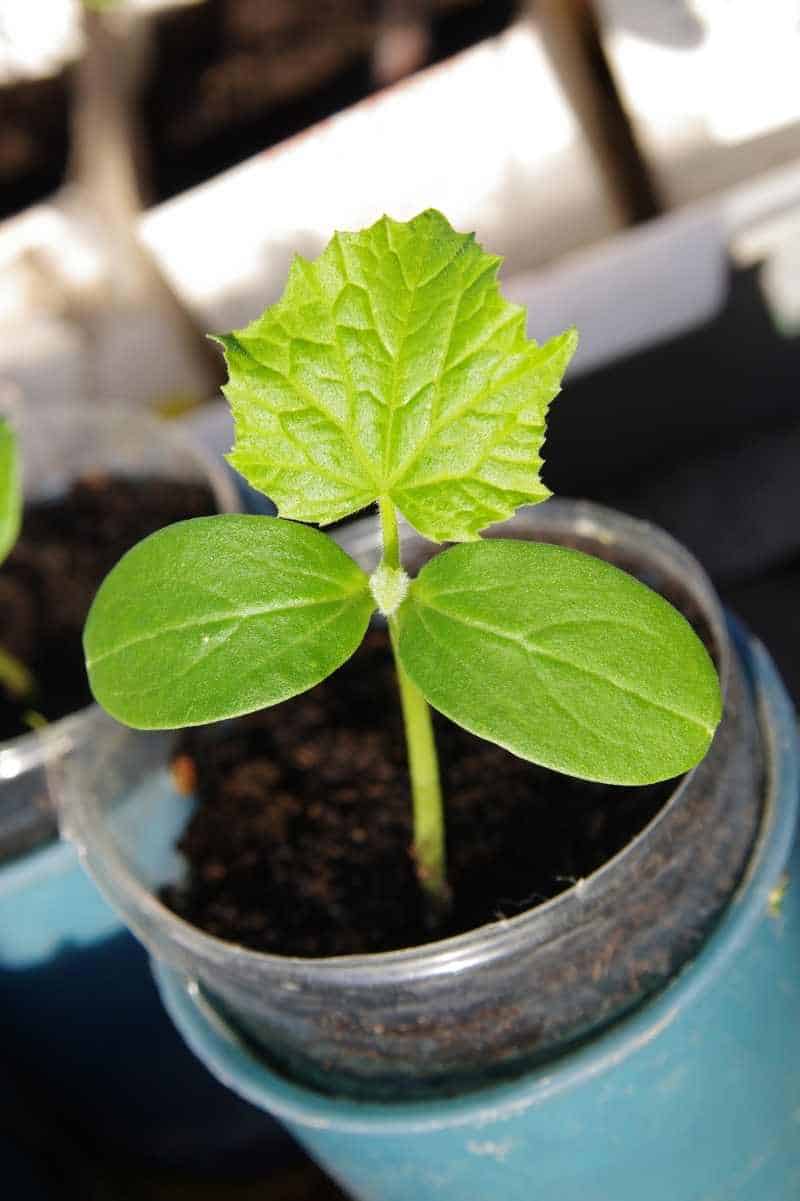
Should I start my cucumbers indoors?
Cucumbers dislike being transplanted. If you live in a cooler climate and need a head start on the growing season, start your cucumbers no more than three to four weeks ahead of your projected transplant date. This way you gain a month on the growing season without the plants growing so large that they can’t recover from the transplant shock.
To start your seeds indoors, place three seeds in a four-inch pot filled with seed starting mix. Make sure they stay warm by keeping them in a warm room or using a seed starting mat under your pots. Shortly after the first set of true leaves appears, thin the cucumbers to one plant per pot by pinching off the stem.
Growfully Protip
In our 6b gardens, we’ve experimented with direct sowing our cucumber seeds and starting the seeds indoors in side-by-side trials. We haven’t seen a difference in harvest time or plant health. The direct sow seeds catch up to the transplanted seeds within a few weeks. So if you can, save yourself the effort and direct sow!
How to grow cucumbers from seed
Cucumber plants have fragile roots when they’re young. It’s best to direct sow cucumber seeds if your climate allows. This avoids the risk of transplant shock.
Your soil needs to be at least 70°F to direct sow your seeds, but the ideal germination temperature is 80-95°F. To help warm up the soil, cover it with dark-colored landscape fabric or black plastic for 10-14 days before planting. Once the soil has warmed, remove the cover, plant your seeds, and keep them covered with a floating row cover or garden cloche if the weather is still cool.
Growfully Protip
There are several varieties of cucumbers that are bred to have a shorter growing season. If you’re in a cooler climate, it’s best to find a short-season variety so you can direct sow them in the ground.
How to grow cucumbers (direct sow method)

- Ensure your location gets six to eight hours of sunlight a day and has well-drained soil. If growing a vining variety, set your trellis or ensure there is space for the plant to sprawl.
- Prepare the soil. Cucumbers are heavy feeders with vigorous growth, so we recommend amending the bed where you will grow cucumbers with well-rotted manure or rich compost.
- If you’re in a cool climate, it’s a good idea to warm up the soil in advance using a piece of black plastic or dark-colored landscape fabric.
- Sow seeds or transplant seedlings when the soil has warmed to at least 70°F. You can plant your cucumbers in hills or in rows. To plant your cucumbers in hills, mound up your soil, and place two to three seeds equally spaced around the hill. Plant seeds to a depth of one inch. When planting your cucumbers in rows, allow four to five feet between plants for bush varieties and vining varieties without a trellis and one foot apart if you’re using a cucumber trellis. Plant 2-3 seeds per spot an inch deep.
- Thin the seedlings. Once the plants have reached roughly four inches, snip off the weaker seedlings, leaving one plant per hill or per 4-5 feet in a row. It’s important to snip the seedling at the base of the plant instead of pulling them. Yanking out your seedlings can damage the remaining plant’s roots.
- As the plants grow, they will naturally attach to the trellis, but you can help them along by twisting in any rogue vines.
- Water plants regularly throughout the season, and keep the plants weeded. Check regularly for signs of disease or pest infestation.
- Harvest cucumbers when they are still small for the best flavor and texture.
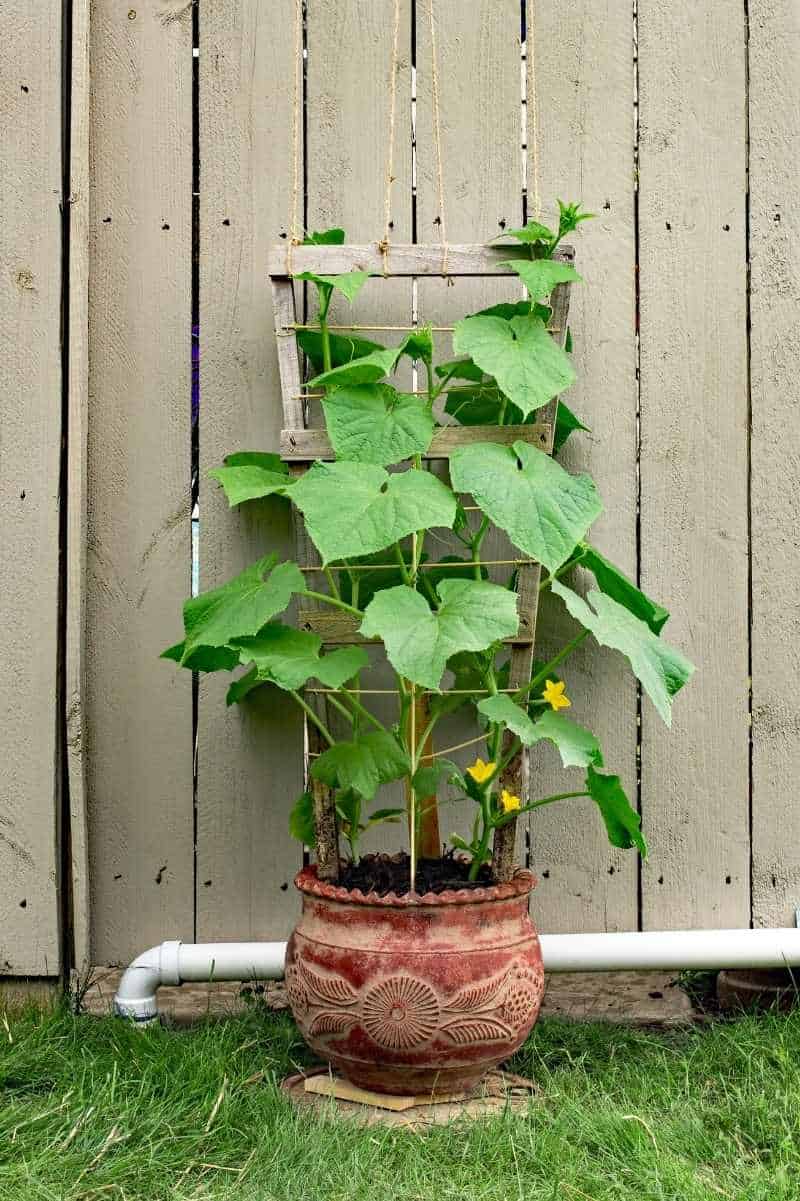
How to grow cucumbers in containers
You can grow cucumbers in containers if you’re short on garden space. We recommend a compact or bush variety.
Cucumbers need a vigorous root system to support the growth of their large vines. Your pot should be at least a foot deep to support the roots. Five-gallon containers work well. Plastic or ceramic pots will retain moisture better for these water-loving plants.
Plant three or four seeds per pot and thin to one plant by snipping off the weaker seedlings once they’re several inches tall.
Cucumbers grown in pots will benefit from trellising. A simple way to trellis your container-grown cucumbers is to use a tomato cage.
Do cucumbers need a trellis?
Not necessarily. You can let your cucumber plants sprawl on the ground, but there are some distinct advantages to trellising. Growing cucumbers vertically can maximize your garden space, while also making for healthier plants.
Cucumbers can grow up pretty much any trellis, fence, arbor, or archway. Ensure your cucumber trellis is at least four to five feet tall, has webbing or netting for the vines to latch onto, and is sturdy enough to support the weight of the vines and fruit. You can build an A-frame trellis using some wood covered in chicken wire, allow the vines to climb up your garden fence, or use a tomato cage.
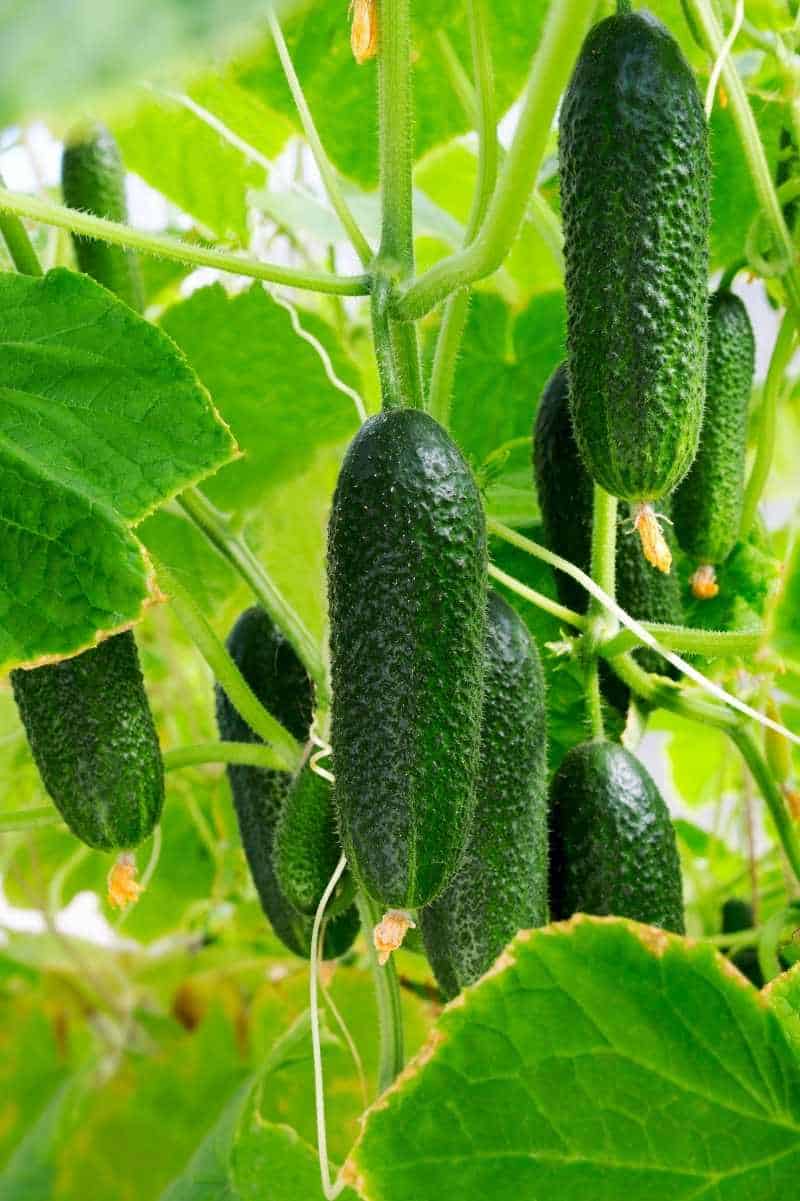
How do I care for my growing cucumbers?
Cucumbers are relatively simple to grow once you have them established.
Weeding cucumbers
You’ll want to keep the weeds at bay around your cucumbers to reduce competition. After your cucumber plants are established, place a thick layer of mulch around the plant to help cut down on weeds. Organic mulch such as straw or chopped leaves will do the trick. Eventually, the cucumber leaves will grow thick enough to act as their own mulch to block out weed growth.
Watering cucumbers
Watering is the most important step in growing cucumbers. To avoid bitter-tasting fruit, your cucumber plants require at least an inch of water a week. High temperatures will increase the amount of water your plants need.
When watering, avoid splashing water droplets onto the leaves as this can breed plant diseases. Instead, aim a slow stream of water around the base of the plant or use drip irrigation. As cucumber plants begin to set fruit, you’ll want to increase the water your cucumber plants receive to between 1 and 2 inches per week. Mulch will also help retain moisture and keep your cucumber plants from drying out.
Fertilizing cucumbers
Cucumbers are heavy feeders, but if you are growing them in rich soil that you amended with manure, organic matter, or compost, you shouldn’t need to do much additional fertilization. In fact, over-fertilization with nitrogen can cause you to have big, beautiful, lush cucumber plants…that don’t produce any cucumbers at all.
In our gardens, we use a biweekly foliar fertilizer of diluted fish emulsion and liquid kelp. This is a balanced fertilizer that keeps our plants strong and lush.

Rotation planting cucumbers
Rotation planting can help prevent pests and plant diseases that may overwinter in your soil. Rotation planting can also help restore nutrients to the earth that the previous year’s crop may have depleted.
Cucumbers are members of the cucurbits family. Do not plant cucumbers immediately before or after any other member of this family, including all squash, melons, pumpkins, or gourds. After your cucumbers have finished for the year, it’s a good idea to follow them with a legume such as peas or beans to help replenish the nitrogen in the soil.
Companion plants for cucumbers
Some plants grow better when planted alongside other plants. Cucumbers are great companions for a variety of other garden vegetables. If you trellis cucumbers, you can use the natural shade they provide. Planting lettuce under the trellis protects the fragile leaves from harsh sunlight, for example. Learn more about cucumber companion plants and what not to plant with cucumbers in our companion planting guide.
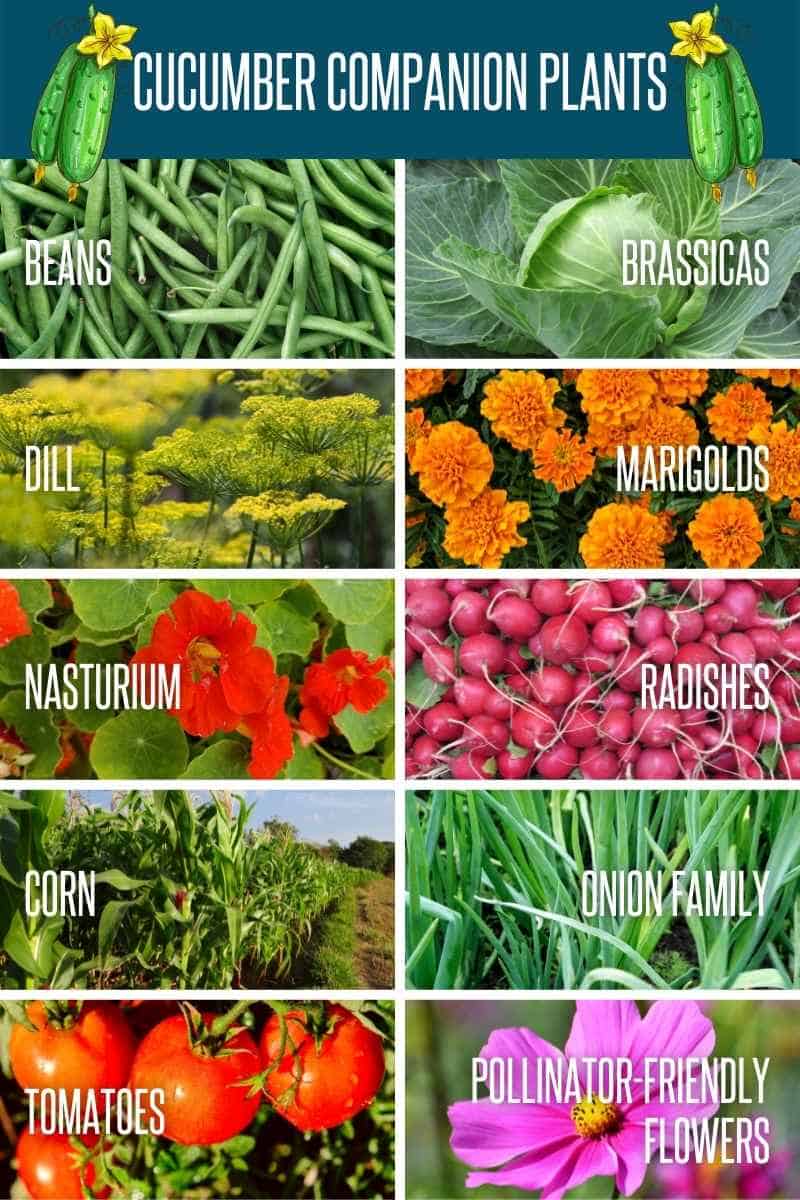
Cucumber pests and disease
Cucumbers can become susceptible to pests and diseases. It’s always better to prevent disease and pests than fight them once they’ve become established. Careful watering, a good mulch, a trellis for airflow, and choosing the right varieties will prevent most pests and diseases.
Cucumber pests:
- Cucumber beetle—An insect that leaves holes in your plants while stunting their growth. Cucumber beetles may also cause bacterial wilt.
- Aphids—A common garden pest, aphids are tiny bugs that cause yellowed leaves, mishappen fruit and flowers, and a sticky “honeydew” coating on your plants. Attracting beneficial insects such as ladybugs, parasitic wasps, and lacewings can help control these pests. Companion planting mustard, chives, and nasturtium can attract the aphids away from your plants, while catnip repels the insects. A solution of water and dish soap or a sprinkling of diatomaceous earth can also get rid of aphids.
- Squash bugs— A ½ inch long insect with a flat back that is hard to remove once established. They inject the leaves of plants with a toxin before sucking the sap from them. Squash bugs tend to choose other cucurbit family plants first, but they will go after cucumbers if desperate.
Cucumber diseases:
In our hot and humid 6b garden, cucumber disease is far-and-away the number one cause of cucumber plant death. Overall, good air circulation, proper watering, and choosing disease-resistant varieties can help you keep diseases at bay.
- Cucumber Mosaic Virus causes white, yellow, and green mottling on the fruit or circular leaf patterns. It may lead to distorted and warty fruit. The only way to get rid of the mosaic virus is to destroy the affected plants before it can spread. Prevention is the key, so look for cucumber varieties that have a resistance to the virus, and always make sure your tools and garden are clean and weeded.
- Powdery Mildew leaves a white coating on the top side of leaves that looks like flour. Destroy any plants infected with powdery mildew. Choose cucumber varieties that are resistant to this disease. Always make sure there’s enough air circulation around our plants so sunlight can evaporate any water that might cling to damp areas. Powdery mildew is a slow-moving disease, so it may take an entire growing season before a plant dies from it.
- Downy Mildew first appears as yellow splotches on the top of leaves with purplish fuzz on the undersides. Avoid overhead watering and allow for plenty of air circulation to prevent downy mildew.
- Blossom End Rot is characterized by dark spots on the end of the cucumber opposite the stem. Over time, these spots may get bigger and appear sunken. Calcium deficiency causes blossom end rot (in particular, calcium not making it all the way to the blossom end of the vegetable). Make sure your soil is rich with good drainage before planting your cucumbers. Make sure to water deeply, evenly, and regularly. If this doesn’t fix the problem, try increasing the calcium of your soil by adding crushed eggshells or bone meal to the top layer of soil.
- Alternaria Leaf Spot, Anthracnose, and Fusarium Wilt are all fungal diseases that can infect curcubits like cucumbers. Plant disease-resistant varieties, practice crop rotation, and avoid overhead watering to prevent these diseases from taking hold.
Growfully Protip
A home remedy for cucumber disease prevention is a regular spray routine of diluted hydrogen peroxide. There isn’t science to back this up, but there are thousands of gardeners who swear by it (and we’ve had good results in the Growfully Gardens, too). Mix 1 teaspoon of 3% hydrogen peroxide per cup of water and spray liberally on your plants weekly (make sure to get the undersides of leaves and stems, too) as a preventative.

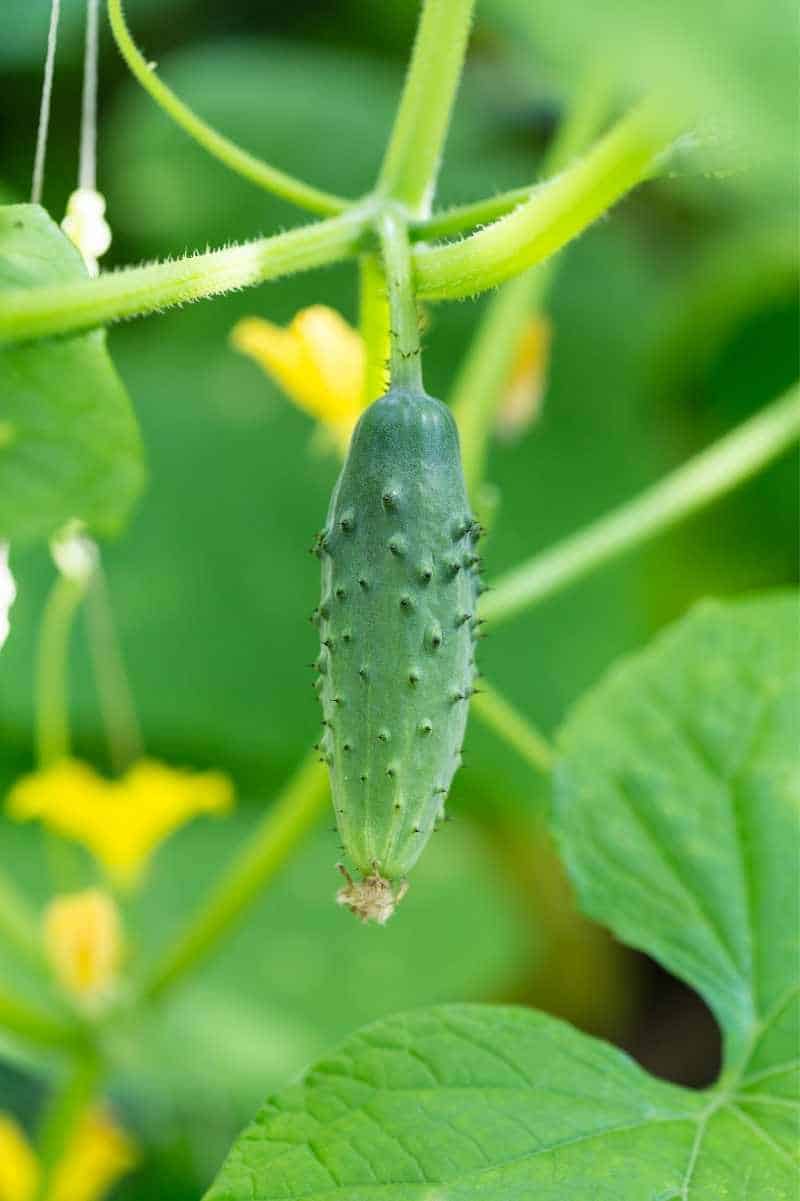
Why are my cucumber plants not producing any cucumbers?
Typically when a cucumber plant doesn’t produce fruits (or produces small fruits that shrivel up and die before developing fully), it’s a pollination problem. While cucumbers are self-pollinating—meaning they have both male flowers and female flowers on the vine—if you don’t have many bees or other pollinators to spread the pollen, you’re out of luck!
For the long-term, we recommend increasing pollinator activity by planting lots of pollinator-friendly plants in your garden. For the short term, you might need to hand pollinate your cucumber vines. To do this:
- Carefully remove a male flower from the plant. Male flowers have a stamen, which is a pollen-covered stalk in the center of the flower.
- Strip away the petals of the male flower so that only the stamen is left.
- Find a female flower—they will sit atop an immature, tiny cucumber. Insert the stamen from the male flower into an open female flower and gently tap the stamen on the stigma (a small, sticky knob in the female flower).
- Try to coat the stigma with as much pollen as possible. As long as there is pollen left on the stamen, you can use the same male flower several times on other female flowers.
Yuck! My cucumbers are bitter!
No worries. It happens to the very best of gardeners! Bitter cucumbers are a sign of plant stress—typically either from heat stress or water stress. If your plants have been allowed to dry out while the fruit is forming or if your weather has been unseasonably hot, that can cause cucumbers to turn bitter. Increase your watering during hot, dry periods to try to counteract the bitterness.
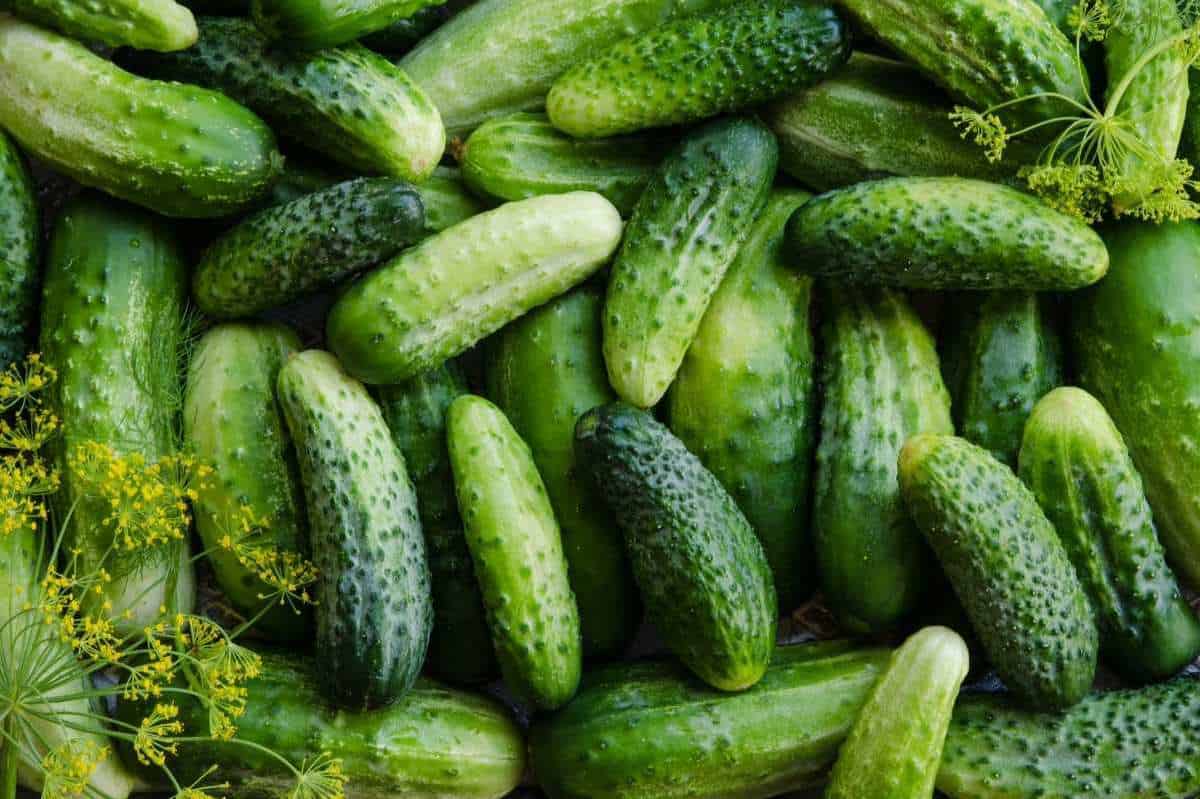
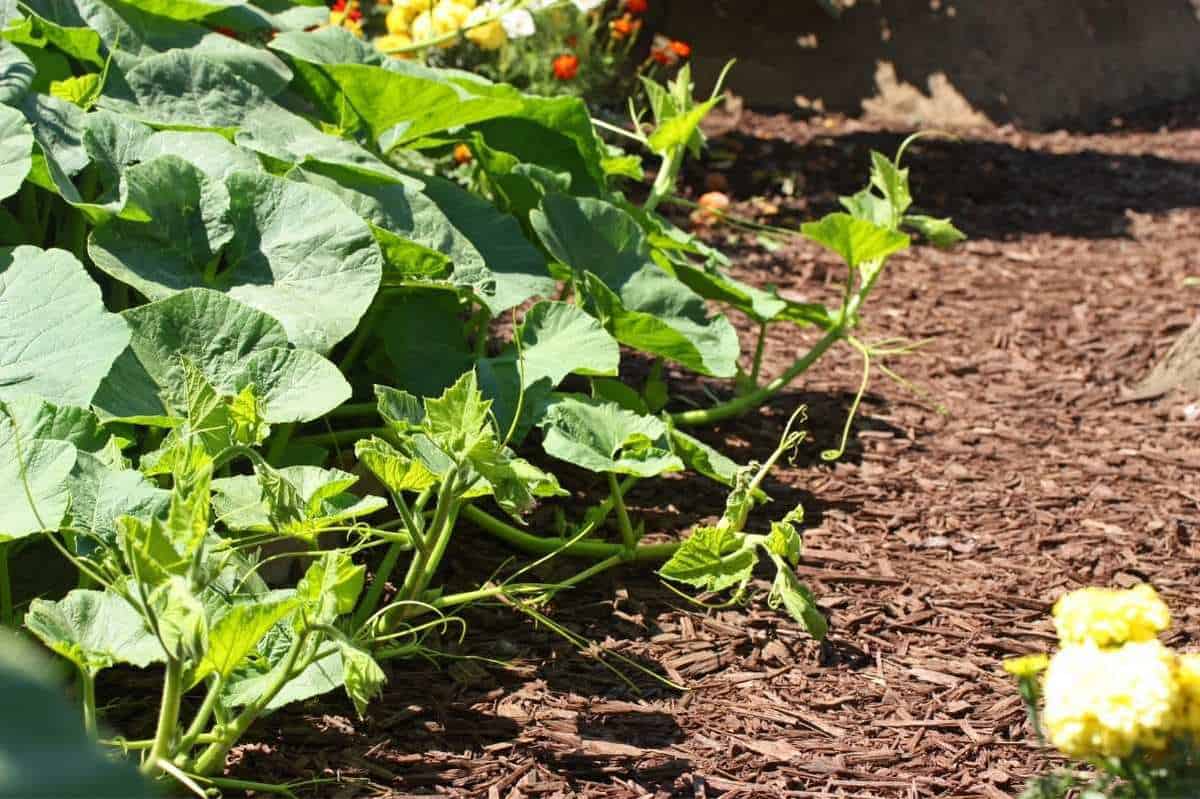
How many cucumbers will I get per plant?
Cucumbers are a great vegetable to plant in the garden because you get a large harvest off of a single plant. As long as your cucumber plant is healthy, you can expect to get 3 to 5 pounds of cucumbers per vining plant—that’s between 15-30 cukes depending on the variety. It’s recommended to plant one plant for every cucumber-loving member of your household.
Growfully Protip
Cucumber plants will slow production if you leave mature cucumbers on the vine. Make sure to harvest your cucumbers as they mature to maximize your harvest.
How to harvest cucumbers
It may be tempting to leave your cucumbers on the vine until they’re massive; however, cucumbers are at their tastiest when they’re still on the smaller side. Look for cucumbers that are dark green with smooth skin. Yellowing is a sign that the cucumbers sat on the vine too long. Cucumbers that have become overly mature will have tougher skin, larger seeds, and be more bitter. A good rule of thumb to remember: you can never harvest a cucumber when it’s too small, but you can harvest it when it’s too big!
To harvest your cucumbers, use a sharp knife or scissors to cut the cucumber from the vine. Pulling them off will cause damage to the vine, so it’s best to use sharp clippers or a knife to slice the fruit away from the plant. However, if you don’t have a knife or scissors handy, you can twist the cucumber until the stem separates from the vine.
Once the growing season gets going, you can expect to be harvesting cucumbers every few days.
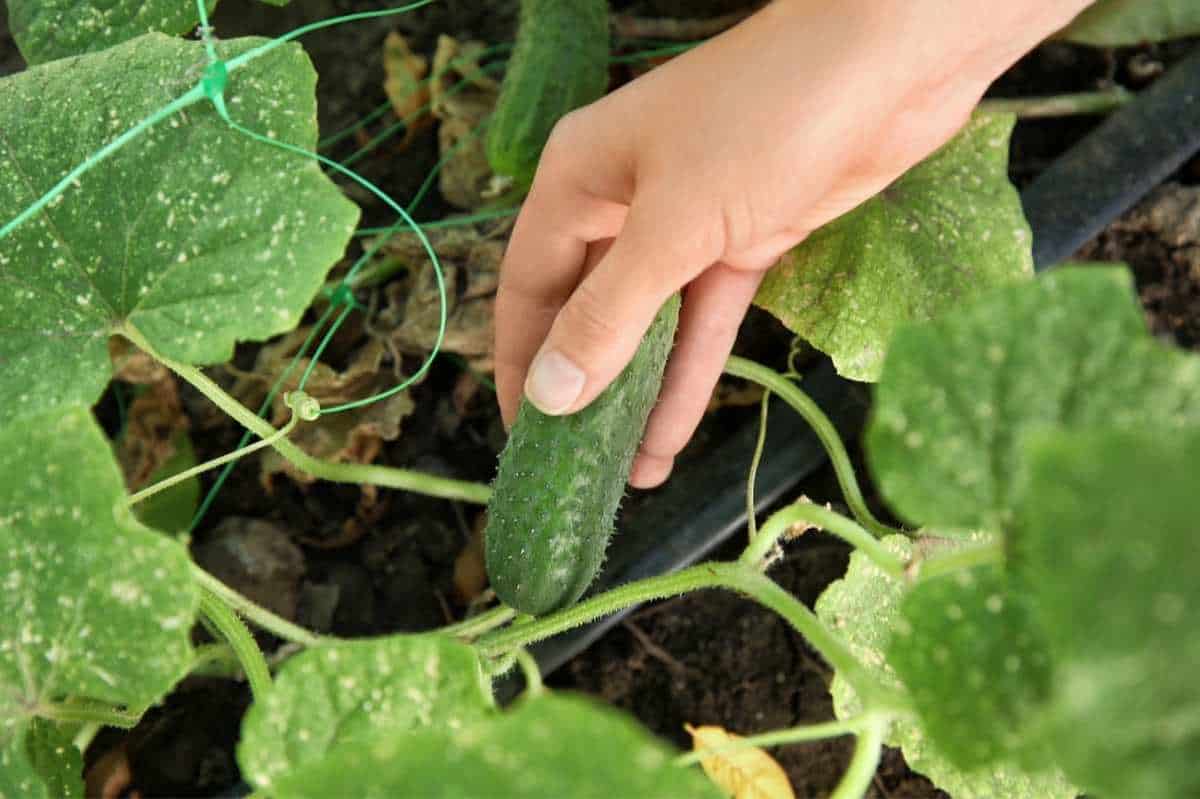
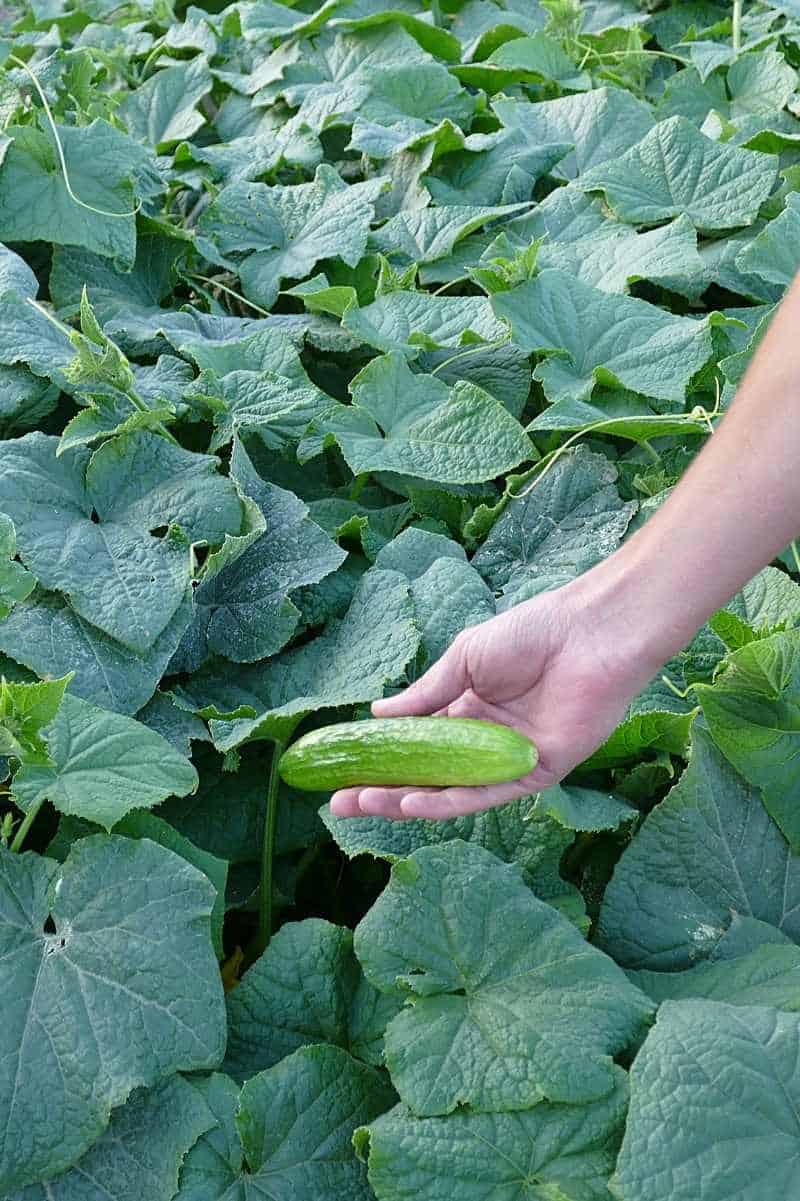
How to store cucumbers
The key to storing fresh cucumbers is retaining moisture. Wrap your cucumbers in a damp towel or a damp terrycloth veggie storage bag and keep them in the crisper drawer in your fridge for a week to ten days.
Cucumbers can also be turned into pickled products, such as bread and butter pickles, relishes, or dill pickles.

How to Grow Cucumbers
Materials
- Cucumber seeds
Tools
- Well-rotted manure or compost
- Trellis or tomato cage (optional but recommended)
Instructions

- Here comes the sun. Cucumbers need at least five hours of sunlight daily, but 6-8 hours a day is even better.
- Water well. Cucumber plants are very thirsty, and your cucumbers will be bitter if they don’t get enough water. Water the base of the plant and avoid watering the leaves to prevent disease.
- Keep it warm. Cucumbers need warm weather to grow. Plant out around 2 weeks after the last frost date, and protect the plants with floating row covers if the temperatures dip.
- Feed me. Cucumbers are heavy feeders with vigorous growth, so amend the bed with well-rotted manure or compost before planting cucumbers. Avoid nitrogen-heavy fertilizers, as this can lead to lush leaves and few cucumbers.
- How to plant. Direct sowing is recommended. Plant cucumbers in hills or rows, 1 inch deep.
- Grow vertically. Using a trellis or tomato cage to train the vines to grow vertically will improve airflow around your cucumbers and save you garden space.
- Harvest when small. For the best flavor, harvest cucumbers when they are still relatively small.

